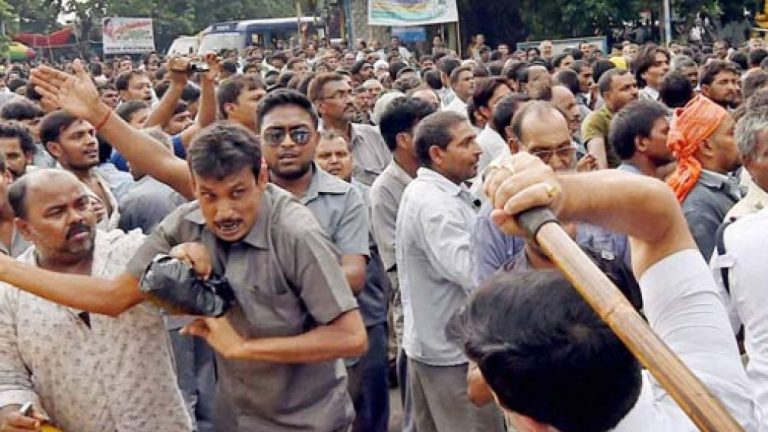

Our world has changed. So has Bengal. A lot of savage behavior of people, of a disturbing nature—particularly in rural areas, is noticed only in West Bengal. During the ongoing election season, even women candidates were attacked by men.
By Nazarul Islam
I am sure Geneticists have never found any special streak of violence in Bengali genes – except when it comes down to a serious, armed struggle for Liberation. Born and raised in Dacca, I often wondered why Bengal has witnessed so much poll violence on the western front.
I remember a half century ago, such incidents were widespread in North India where the upper castes used to stop Dalits and OBCs (other backward classes) visiting the booths. Twenty-five years ago, violence was still rampant in Uttar Pradesh, Bihar, Kerala and Bengal.
But, our world has changed. So has Bengal. A lot of savage behavior of people, of a disturbing nature—particularly in rural areas, is noticed only in West Bengal. During the ongoing election season, even women candidates were attacked by men.
The question has remained: Why does it happen only in Bengal? And the answer is simple. Unlike in other states, the elections in Bengal engulf the vested interests of a large number of people dependent on the ruling party for their livelihood, legal or illegal.
Let’s examine how wide and deep, the rot of the land of our forefathers has stemmed…
In Bengal, people not loyal to the ruling party won’t be enrolled in the rural job scheme, set for National Rural Employment And those who are active workers of the party may get half the wages (with the other half going to the party) even without having to toil or work in the project.
Quite expectedly, the benefits of government schemes are unlikely to reach those who are known to be supporters of opposition parties. The money for housing will go to a core supporter who may have a good shelter, but not to those without a proper roof over their heads, if they are marked as ‘opponents’.
Again, regardless of all such government schemes, living in rural or semi-urban areas — a daily wage earner like a hawker or a vegetable vendor, a schoolteacher or a professor or an ordinary farmer — will face different kinds of hardships, if they were recognized as supporters of the Opposition party.
One could face harassment while trying to obtain necessary certificates from the panchayat or the MLA. If a disaster strikes, say a flood or a cyclone, relief materials are first distributed among party supporters (even if they are not impacted), and the remaining will go to passive supporters.
To run such a system of absolute control, the ruling party of the state (or, at times, the party that controls the district panchayat or the block panchayat) needs a network of cadres in every neighborhood.
And … how does this evil system function? First, by distributing ‘favors’, and second, by employing ‘harmads’ (armed criminals)
In several states, jobs such as that of teachers, professors and government employees are sold for money. In Bengal, one cannot just buy a job by paying bribes.
Here, most of the jobs are distributed among active workers of the ruling party and their children. The rest of the cadres survive on money collected mostly illegally and often through coercion.
Across the state, there are lakhs of such ‘political parasites’ whose survival depends on the return of the ruling party to power. Reportedly, often take the help of seasoned criminals to silence and terrorize opposition supporters.
The ongoing situation has roots therefore it is unlikely to change. The seeds of this system were sown during the days of Siddharta Shankar Roy, the last Congress chief minister (1972-1977) of Bengal.
But it grew to a menacing proportion in the last 20 years of the Left Front’s 34-year (1977-2011) regime, which was then taken forward by the Trinamool Congress (TMC), ruling the state for the last decade.
Watch the video: Violence in Bengal
The irony is that such a system cannot satisfy the majority of people, which results in some always revolting against it. When the number grows to a dangerous level, the ruling party’s well-oiled mechanism takes recourse to violence and terrorization of people.
Such violence was noticed only in the last 10 years of the Left Front government, and has been revived now in the last three years (from the time of panchayat elections of 2018, when the polls were reduced to a farce) of the present TMC regime.
When the disgruntled section tries to veer around the Opposition, a section of the ‘cadres’, particularly hooligan elements, breaks ranks to join the Opposition party stronger in the region. But the process becomes intense when the index of voters’ polarization towards a single Opposition force throughout the state goes up. And it becomes a do-or-die situation for both the main rivals. This type of vested interest does not exist in any other state, which is why they are often unable to rid of political violence and killings.
We must understand that the collective fear stimulates herd instinct and tends to produce ferocity towards those who are not regarded as members of the heard. Perhaps….An eye for an eye will only make the whole world blind. Violence is the last refuge of the incompetent. Sometimes you have to pick the gun up to put the Gun down.
This disturbing situation in the west side of Bengal is unlikely to change, should the BJP come to power in Bengal. The saffron party, too, will be happy to continue with the system, for the deep and wide rot is an easy and tested strategy and a recipe for clinging on to power, as long as possible.
_____________________
About the Author
 The Bengal-born writer Nazarul Islam is a senior educationist based in USA. He writes for Sindh Courier and the newspapers of Bangladesh, India and America. He is author of a recently published book ‘Chasing Hope’ – a compilation of his 119 articles.
The Bengal-born writer Nazarul Islam is a senior educationist based in USA. He writes for Sindh Courier and the newspapers of Bangladesh, India and America. He is author of a recently published book ‘Chasing Hope’ – a compilation of his 119 articles.